Gaze
Donor
- MBTI
- INFPishy
http://lifeasahuman.com/2010/humor/do-looney-cartoon-characters-show-signs-of-mental-illness/
Posted by George Burden | Tuesday, July 6, 2010 at 12:15 am
Responses | 0
 It’s a hotbed of psychopathology rivaling that of any daytime soap opera. These individuals cover the entire spectrum of mental illness as outlined by the psychiatrist’s bible, the so called DSM-IV (revised).
It’s a hotbed of psychopathology rivaling that of any daytime soap opera. These individuals cover the entire spectrum of mental illness as outlined by the psychiatrist’s bible, the so called DSM-IV (revised).
I am referring, of course, to the stable of unstable “Retro” cartoon characters to which Warner Brothers subjects our children on a regular basis.
Come on, you can’t tell me you didn’t realize these guys had serious problems? Let’s take the Tasmanian Devil, for example. With such poor impulse control one can’t help but diagnose hyperactivity.
While he pursues Bugs Bunny his distractibility consistently proves to be his undoing, confirming that attention deficit is also present. Clearly ADHD is present of the predominantly hyperactive impulsive type, diagnostic code 314.01.
Moving on to Daffy Duck, the diagnosis of paranoia immediately takes wing. This whining, overbearing, insecure creature must surely be more pitied than blamed. He has strong goal-seeking behavior, and yet his poor social skills and outbursts of temper often sabotage his success.
Daffy Duck, the diagnosis of paranoia immediately takes wing. This whining, overbearing, insecure creature must surely be more pitied than blamed. He has strong goal-seeking behavior, and yet his poor social skills and outbursts of temper often sabotage his success.
Daffy thinks the world is out to get him. He is suspicious of everyone’s motives, bears grudges and trusts no one. This behavior consistently alienates him form others, only further aggravating his paranoid ideation.
Clearly he has had some bad experiences as a duckling. Label him paranoid personality disorder, cluster A, diagnostic code 301.0.
Yosemite Sam manifests a pervasive pattern of disregard for the rights of others. He fails to respect the law, is unable to delay gratification and is deceitful in his dealings with others. He is irritable and aggressive, resulting in frequent fights or assaults.
Sam shows little regard for his own safety or that of others. Yet his impulsiveness and failure to plan appropriately frequently frustrate his efforts. Sam’s a typical antisocial personality disorder, cluster B, diagnostic code 301.7.
Now Marvin the Mar tian is an interesting study. He has a one-track megalomaniacal desire to conquer the world and will calmly disintegrate anyone who gets in his way, without remorse. He is clearly delusional if he believes that, even with advanced technology, he can do this single handedly (or at most with the help of his dog).
tian is an interesting study. He has a one-track megalomaniacal desire to conquer the world and will calmly disintegrate anyone who gets in his way, without remorse. He is clearly delusional if he believes that, even with advanced technology, he can do this single handedly (or at most with the help of his dog).
Marvin most likely suffers from a psychotic, delusional disorder of the grandiose type, diagnostic code 297.1. His dog on the other hand shares his master’s delusion in that he slavishly follows him despite Marvin’s illness and clearly should be labeled a share psychotic disorder (“folie a deux”), 297.3.
Pepe LePew is another sadly disturbed character. He is preoccupied with fantasies of ideal love and therefore follows and victimizes a helpless and hapless feline.
He lacks the empathy to see that his feelings are unrequited and shows an unreasonable sense of entitlement to the affections of the poor cat. Obviously we are dealing with a narcissistic personality disorder here, cluster B, diagnostic code 301.81.
The cat herself shows signs of pathological passivity in that she does not seem to express her rejection in an effective and assertive manner to Pepe. Her half-hearted attempts to escape make one wonder if she enjoys the victim role. Perhaps at a subconscious level she likes the attention.
 Tweety and Sylvester pose an interesting diagnostic dilemma. At first one tends to label Tweety as the victim and Sylvester as the victimizer. But look at what happens in a typical interaction. Tweety maintains a pose of innocence while engineering all sorts of horrible events for Sylvester.
Tweety and Sylvester pose an interesting diagnostic dilemma. At first one tends to label Tweety as the victim and Sylvester as the victimizer. But look at what happens in a typical interaction. Tweety maintains a pose of innocence while engineering all sorts of horrible events for Sylvester.
The cat falls from great heights, is attacked by aggressive canines and otherwise is beaten, maimed and subjected to all sorts of negative life experiences. Who is really the victim here?
Tweety is a typical passive aggressive personality. Unfortunately, this useful term seems to have been engineered out of the present DSM-IV (revised), so I can’t give it a code number.
What about Sylvester? He seems to be a co-dependent in this sick relationship. Why doesn’t he just leave, or seek counselling to escape this cycle of violence? Alas, he could be a little better endowed in the brain department (witness his mistaking a baby kangaroo for a mouse).
 Wile E. Coyote and Road Runner present the single-minded fanatic and the object of his fanaticism. Wile E. is obviously highly intelligent, judging from the various schemes and plans he develops to capture Road Runner. He most certainly manifests strong obsessive-compulsive tendencies as despite consistent failures he is always ready to try one more time.
Wile E. Coyote and Road Runner present the single-minded fanatic and the object of his fanaticism. Wile E. is obviously highly intelligent, judging from the various schemes and plans he develops to capture Road Runner. He most certainly manifests strong obsessive-compulsive tendencies as despite consistent failures he is always ready to try one more time.
It is my opinion that the Coyote shares traits in common with most successful scientific researchers. Perhaps he had previously focused on other, more lucrative areas of inventing and hence the financial wherewithal to purchase myriads of expensive devices from Acme in his pursuit of Road Runner. Also, since he obviously can afford to buy food, his obsessive pursuit of RR suggests other, deeper and darker motives than just hunger.
Elmer Fudd superficially resembles Wile E. Coyote in his single-minded pursuit of his quarry, Bugs Bunny (with an occasional foray into duck hunting). It is evident that he does not share the Coyote’s high intelligence, though in fact IQ doesn’t seem to correlate particularly well with success in either case.
One wonders if Elmer has some doubts about his masculinity, as he is almost always seen holding a large gun with it obvious phallic symbolism.

Finally we must deal with Bugs Bunny himself. Bugs is a relaxed, laid-back sort of fellow, who rarely gets too excited. Even when threatened by various and sundry of his unbalanced brethren, he usually handles the situation with aplomb and sang-froid.
On the Global Assessment of Functioning Scale in Axis 5 of the DSM-IV (revised), we could say he shows “superior functioning in a wider range of activities, life’s problems never seem to get out of hand and he is sought out by others because of his many positive qualities”.
My only qualm is his dependency problem with carrots. While it could be argued that this is not really an addiction, Bugs enters risky situations for these crunchy treats. I’ll leave this one at a questionable diagnosis DSM 304.9, “other substance abuse”.
It would seem from the great number of disordered cartoon characters in film and television that normalcy is a condition which may be desirable, but makes for boring programming. As Pepe LePew would say: “Vive la difference!”
Posted by George Burden | Tuesday, July 6, 2010 at 12:15 am
Responses | 0
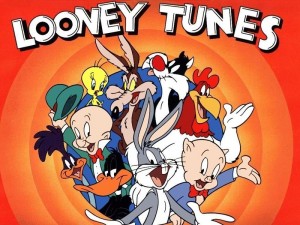 It’s a hotbed of psychopathology rivaling that of any daytime soap opera. These individuals cover the entire spectrum of mental illness as outlined by the psychiatrist’s bible, the so called DSM-IV (revised).
It’s a hotbed of psychopathology rivaling that of any daytime soap opera. These individuals cover the entire spectrum of mental illness as outlined by the psychiatrist’s bible, the so called DSM-IV (revised).I am referring, of course, to the stable of unstable “Retro” cartoon characters to which Warner Brothers subjects our children on a regular basis.
Come on, you can’t tell me you didn’t realize these guys had serious problems? Let’s take the Tasmanian Devil, for example. With such poor impulse control one can’t help but diagnose hyperactivity.
While he pursues Bugs Bunny his distractibility consistently proves to be his undoing, confirming that attention deficit is also present. Clearly ADHD is present of the predominantly hyperactive impulsive type, diagnostic code 314.01.
Moving on to
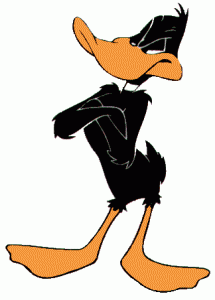 Daffy Duck, the diagnosis of paranoia immediately takes wing. This whining, overbearing, insecure creature must surely be more pitied than blamed. He has strong goal-seeking behavior, and yet his poor social skills and outbursts of temper often sabotage his success.
Daffy Duck, the diagnosis of paranoia immediately takes wing. This whining, overbearing, insecure creature must surely be more pitied than blamed. He has strong goal-seeking behavior, and yet his poor social skills and outbursts of temper often sabotage his success.Daffy thinks the world is out to get him. He is suspicious of everyone’s motives, bears grudges and trusts no one. This behavior consistently alienates him form others, only further aggravating his paranoid ideation.
Clearly he has had some bad experiences as a duckling. Label him paranoid personality disorder, cluster A, diagnostic code 301.0.
Yosemite Sam manifests a pervasive pattern of disregard for the rights of others. He fails to respect the law, is unable to delay gratification and is deceitful in his dealings with others. He is irritable and aggressive, resulting in frequent fights or assaults.
Sam shows little regard for his own safety or that of others. Yet his impulsiveness and failure to plan appropriately frequently frustrate his efforts. Sam’s a typical antisocial personality disorder, cluster B, diagnostic code 301.7.
Now Marvin the Mar
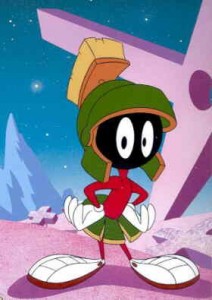 tian is an interesting study. He has a one-track megalomaniacal desire to conquer the world and will calmly disintegrate anyone who gets in his way, without remorse. He is clearly delusional if he believes that, even with advanced technology, he can do this single handedly (or at most with the help of his dog).
tian is an interesting study. He has a one-track megalomaniacal desire to conquer the world and will calmly disintegrate anyone who gets in his way, without remorse. He is clearly delusional if he believes that, even with advanced technology, he can do this single handedly (or at most with the help of his dog).Marvin most likely suffers from a psychotic, delusional disorder of the grandiose type, diagnostic code 297.1. His dog on the other hand shares his master’s delusion in that he slavishly follows him despite Marvin’s illness and clearly should be labeled a share psychotic disorder (“folie a deux”), 297.3.
Pepe LePew is another sadly disturbed character. He is preoccupied with fantasies of ideal love and therefore follows and victimizes a helpless and hapless feline.
He lacks the empathy to see that his feelings are unrequited and shows an unreasonable sense of entitlement to the affections of the poor cat. Obviously we are dealing with a narcissistic personality disorder here, cluster B, diagnostic code 301.81.
The cat herself shows signs of pathological passivity in that she does not seem to express her rejection in an effective and assertive manner to Pepe. Her half-hearted attempts to escape make one wonder if she enjoys the victim role. Perhaps at a subconscious level she likes the attention.
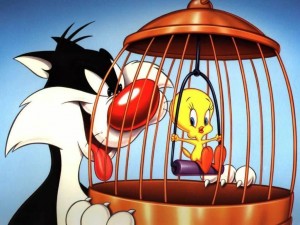 Tweety and Sylvester pose an interesting diagnostic dilemma. At first one tends to label Tweety as the victim and Sylvester as the victimizer. But look at what happens in a typical interaction. Tweety maintains a pose of innocence while engineering all sorts of horrible events for Sylvester.
Tweety and Sylvester pose an interesting diagnostic dilemma. At first one tends to label Tweety as the victim and Sylvester as the victimizer. But look at what happens in a typical interaction. Tweety maintains a pose of innocence while engineering all sorts of horrible events for Sylvester.The cat falls from great heights, is attacked by aggressive canines and otherwise is beaten, maimed and subjected to all sorts of negative life experiences. Who is really the victim here?
Tweety is a typical passive aggressive personality. Unfortunately, this useful term seems to have been engineered out of the present DSM-IV (revised), so I can’t give it a code number.
What about Sylvester? He seems to be a co-dependent in this sick relationship. Why doesn’t he just leave, or seek counselling to escape this cycle of violence? Alas, he could be a little better endowed in the brain department (witness his mistaking a baby kangaroo for a mouse).
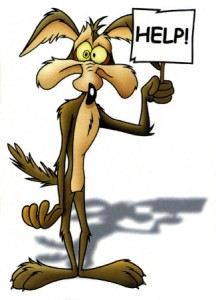 Wile E. Coyote and Road Runner present the single-minded fanatic and the object of his fanaticism. Wile E. is obviously highly intelligent, judging from the various schemes and plans he develops to capture Road Runner. He most certainly manifests strong obsessive-compulsive tendencies as despite consistent failures he is always ready to try one more time.
Wile E. Coyote and Road Runner present the single-minded fanatic and the object of his fanaticism. Wile E. is obviously highly intelligent, judging from the various schemes and plans he develops to capture Road Runner. He most certainly manifests strong obsessive-compulsive tendencies as despite consistent failures he is always ready to try one more time.It is my opinion that the Coyote shares traits in common with most successful scientific researchers. Perhaps he had previously focused on other, more lucrative areas of inventing and hence the financial wherewithal to purchase myriads of expensive devices from Acme in his pursuit of Road Runner. Also, since he obviously can afford to buy food, his obsessive pursuit of RR suggests other, deeper and darker motives than just hunger.
Elmer Fudd superficially resembles Wile E. Coyote in his single-minded pursuit of his quarry, Bugs Bunny (with an occasional foray into duck hunting). It is evident that he does not share the Coyote’s high intelligence, though in fact IQ doesn’t seem to correlate particularly well with success in either case.
One wonders if Elmer has some doubts about his masculinity, as he is almost always seen holding a large gun with it obvious phallic symbolism.
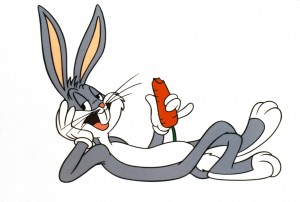
Finally we must deal with Bugs Bunny himself. Bugs is a relaxed, laid-back sort of fellow, who rarely gets too excited. Even when threatened by various and sundry of his unbalanced brethren, he usually handles the situation with aplomb and sang-froid.
On the Global Assessment of Functioning Scale in Axis 5 of the DSM-IV (revised), we could say he shows “superior functioning in a wider range of activities, life’s problems never seem to get out of hand and he is sought out by others because of his many positive qualities”.
My only qualm is his dependency problem with carrots. While it could be argued that this is not really an addiction, Bugs enters risky situations for these crunchy treats. I’ll leave this one at a questionable diagnosis DSM 304.9, “other substance abuse”.
It would seem from the great number of disordered cartoon characters in film and television that normalcy is a condition which may be desirable, but makes for boring programming. As Pepe LePew would say: “Vive la difference!”
Last edited:

